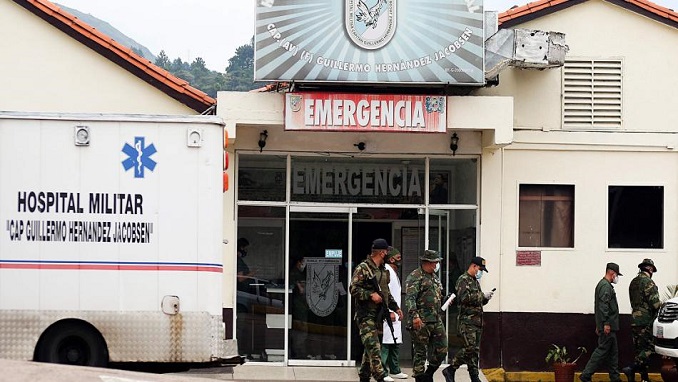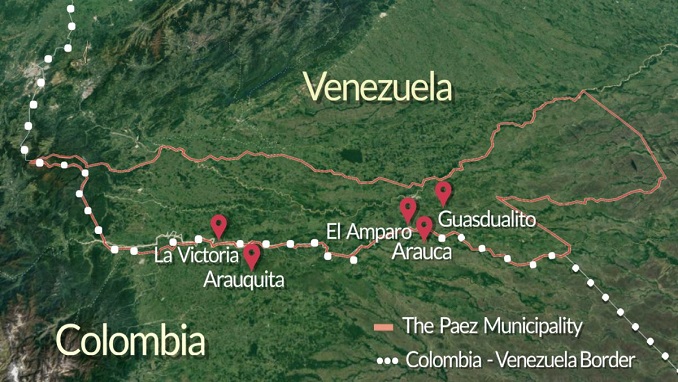The Venezuelan Army has lost at least two officers fighting a group of Colombian irregulars, near the Arauca river. Colombia reports at least 3,000 refugees crossing the border. What does it mean, Caracas Chronicles explains in its article.
Last weekend, different sources reported that a special force of the Venezuelan Army was engaged in combat with a group of Colombian irregulars in the La Victoria area, Apure State, south-western Venezuela. The tension has continued, although the official information is, as usual, very vague, and the area is difficult to reach, with little telecommunications coverage.
We do know the fighting goes on, from diverse reports from people in the region, and from the Colombian Foreign Minister that’s requesting international aid to help more than 3,000 Venezuelan refugees who have crossed the border to find shelter in Colombia.
There are reports of Venezuelan helicopters and K2 bombers in action. People from NGO Fundaredes are sharing videos and photos presumably coming from the area where guerrillas and the Army are hitting each other’s camps and facilities:
The civilians, who are usually trapped between the extortion of Colombian guerrillas and the hostility of a remote government, are fleeing the fight and the military presence. Human rights NGO Provea shared the testimony of an 86-year-old woman from La Victoria, who spoke about how the soldiers stormed her house and pointed their bayonets at the heads of her grandchildren.
Who’s the Army fighting with?
The first reports pointed at a FARC unit or, more specifically, a group of the Colombian guerrilla that operates in Venezuela since it refused to take part in the peace process in Colombia, usually known as “FARC dissidents”.
The communiqué signed by the Venezuelan Defense Minister, General Vladimir Padrino, reported that Major Edward Corobo and First Lieutenant Yonathan Duarte died in combat, and the “neutralization” of a guerrilla leader who went by the alias of “Nando”, adding that the Army had destroyed the enemy camps and equipment.
What Padrino just said is that they were fighting irregulars, but he didn’t identify them as FARC, or as part of any other group. In the ceremony to promote the two fallen Army men post-mortem, Padrino said that “any violent armed group” that causes destabilization and intends to “occupy our territory” for drug trafficking will face a “cohesive response from FANB”.
Colombian media like RCN presumes the Army is fighting a dissident FARC group that’s not controlled by the leaders known as Jesus Santrich and Iván Márquez, historic FARC commanders allegedly living in Venezuela under protection of the Maduro regime.
El Tiempo supports that version, also sharing the hypothesis of Rocío San Miguel, one of Venezuela’s main experts in military affairs: she says the operation is a reprisal against a dissident FARC group that’s conflicting with the rest of the FARC and with the other old Colombian guerrilla, the ELN, which has about 2,000 men in Venezuela.
This makes sense. In our Political Risk Report, we’ve shared what we know about the presence of FARC dissidents in Venezuela, who have been in our country since the peace process in Colombia ended with a split: a part of FARC took the political road in Colombia, another part morphed into gangs, and yet another took refuge in Venezuela, where they participate in the gold business, sometimes competing with local mafias, military rivals or other guerrilla groups like the ELN.
In fact, some weeks ago we reported in our PRR that, according to our sources, Iván Márquez was being moved to a more secure location, far from the border, to protect him from eventual operations by Colombian forces.
Where’s this happening and why is the location relevant?
That region—sparsely populated, hot and flat, difficult to control, and with big rivers ideal to transport drugs and people—has been a theater of drug trafficking, extortion, and kidnapping for Colombian irregulars, especially the ELN, even before the Chávez era.
The Páez municipality, with 12,800 square kilometers (about the size of Connecticut), where cattle production is the traditional economic activity, has seen tensions for decades. During the Chávez days, the presence of guerrillas increased, although it started with a sort of laissez-passer secret policy before the Comandante became president.
Years ago, it was Colombian refugees entering to flee combat on the Colombian side, but now it’s the other way around: Venezuelans fleeing to Colombia, crossing the Arauca river.
It’s a hot place. In 1988, Venezuelan forces killed a group of peasants from El Amparo and said they were guerrillas; the case became one of the most conspicuous human rights violations of the decaying democracy. I visited the area myself, to interview the mayor two decades ago, and by 4:00 p.m., he—the highest civilian authority in the area—told me it was better if I left for the nearest airport as soon as possible, because he was unable to keep me safe.

Now, in the dazzling patchwork of alliances and feuds among corrupt military mafias, police, colectivos, ELN, FARC, and gangs that participate in the legal/illegal economies of Southern Venezuela (state-sponsored gold mining, illegal gold mining, drug and human trafficking, extortion and kidnapping, etc), the Páez municipality can be even more dangerous, when we combine its history of guerrilla activity with the current violent equilibrium in a competition for resources among armed actors that brings Ivory Coast or the Democratic Republic of Congo to mind.
A truly concerning development was pointed out by Rocío San Miguel: she believes the two Army soldiers were killed by land mines, presumably installed by the ELN. This is the first time we’ve known of land mines in Venezuelan territory.
How could this impact the tensions with Colombia and the geopolitical context?
We’ve reported in our PRR that the Maduro regime is considering increasing tensions with Colombia and Guyana, to distract people from their troubles and energize chavista ranks. The recent military exercises (called Escudo Bolivariano) are a part of this strategy.
Though the action in La Victoria—which, according to Fundaredes, was being prepared with heavy mobilization into the area since last week—looks like a collateral effect of a turf war among guerrillas and the military. The fact is that the fight forces the Colombian Army to be on guard, to protect its borders, and increases the risk of provocation and accidents, or a dangerous incident between the Duque and the Maduro rival governments.
We have no reasons to fear for a war between Colombia and Venezuela, but we can’t forget that Venezuela is protecting public enemies of Colombia (the FARC dissidents), and that this is always a source of risks.
Or at least, a source of Russian and Iranian weapon purchases, of chavista chauvinistic propaganda, and of more human rights abuses against Apure inhabitants who try to endure poverty, guerrillas and military pressure.
